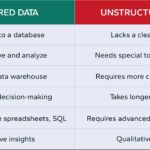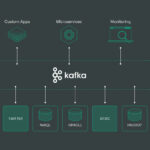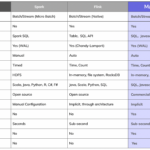Building a scalable data lake architecture is crucial for organizations looking to efficiently manage and analyze vast amounts of big data. A well-designed data lake can provide a centralized repository for raw data from various sources, enabling businesses to derive valuable insights for strategic decision-making. In this article, we will explore key components and best practices for constructing a scalable data lake architecture that can effectively handle the volume, variety, and velocity of big data.
In the era of Big Data, enterprises are increasingly turning to data lakes for their capacity to handle vast amounts of structured and unstructured data. A well-designed data lake architecture can provide organizations with the necessary tools to extract value from their data. This article outlines best practices for creating a scalable data lake architecture that meets the evolving needs of businesses.
Understanding Data Lakes
A data lake is a centralized repository that allows for the storage of data in its native format until it is needed. Unlike traditional data warehouses, which typically require data to be structured and cleaned before storage, data lakes can accommodate raw data, making them ideal for Big Data analytics.
Key Components of a Scalable Data Lake Architecture
1. Data Ingestion
Data ingestion is the process of collecting and importing data from various sources into the data lake. For a scalable architecture, consider the following strategies:
- Batch Ingestion: This method is ideal for large volumes of data processed at scheduled intervals. Technologies like Apache Sqoop or Apache Kafka can help automate batch ingestion.
- Real-Time Streaming: For real-time analytics, utilize streaming technologies such as Apache Kafka or AWS Kinesis. These enable continuous data flows into the lake.
2. Data Storage
Choosing the right storage solution is crucial for scalability:
- Cloud Storage: Solutions like Amazon S3, Azure Data Lake Storage, or Google Cloud Storage offer elasticity and cost-effectiveness for storing large volumes of data.
- Data Format: Use open formats like Apache Parquet or ORC for efficient storage and faster query performance. These formats support schema evolution and compression techniques.
3. Data Processing
After ingestion, raw data needs processing to derive insights. Consider incorporating following processing techniques:
- Batch Processing: Use frameworks like Apache Spark and Apache Hadoop to process large datasets in batch. These technologies support distributed processing, making them scalable.
- Stream Processing: For real-time analytics, tools like Apache Flink and Apache Storm can process data instantly as it flows into the lake.
Designing the Data Lake Architecture
1. Use a Lambda Architecture for Flexibility
Implementing a Lambda architecture combines batch and real-time processing, providing the benefits of both. The architecture consists of three layers:
- Batch Layer: This layer manages the master dataset and pre-computes batch views.
- Speed Layer: This layer deals with real-time or near-real-time data processing. It processes rapid data changes.
- Serving Layer: The final layer provides data to users for querying, combining both batch and real-time results.
2. Adopt a Microservices Approach
A microservices architecture allows for independent deployment and scalability. Each microservice can handle different data processing tasks (ingesting, transforming, etc.). This modular approach enhances agility and performance while minimizing resource contention.
3. Data Governance and Management
Implementing robust data governance ensures data integrity and compliance:
- Data Cataloging: Invest in tools like Apache Atlas or AWS Glue for metadata management and data lineage tracking.
- Security Policies: Establish role-based access controls (RBAC) to safeguard sensitive data and adhere to regulations like GDPR or HIPAA.
Tools and Technologies for Scalable Data Lakes
Several tools play crucial roles in building a scalable data lake architecture. Below are some popular ones:
1. Data Ingestion Tools
- Apache NiFi: For data routing and transformation.
- Logstash: To collect, parse, and store logs for better insight.
2. Data Storage Solutions
- Hadoop Distributed File System (HDFS): For reliable and distributed storage.
- Azure Blob Storage: Ideal for enterprises already leveraging Microsoft’s cloud ecosystem.
3. Data Processing Frameworks
- Apache Spark: Great for large-scale data processing with an easy-to-use interface.
- Apache Beam: For creating data processing pipelines that can run on various execution engines.
4. Data Analytics and Visualization Tools
- Tableau: Powerful for visualizing data insights.
- Apache Superset: An open-source tool for data exploration and visualization.
Ensuring Scalability
Scalability is not merely about handling more data; it’s about adaptability:
1. Elastic Scaling
Utilize cloud-based solutions that enable elastic scaling. Technologies such as Kubernetes offer orchestrated container management, allowing services to scale based on demand.
2. Data Partitioning
Partitioning data in your lake can significantly enhance query performance. Consider sharding your data based on criteria such as time intervals or user segments.
3. Caching and Materialized Views
Implementing caching mechanisms can drastically reduce query response times. Materialized views can also store pre-computed results, allowing for quicker retrieval.
Monitoring and Optimization
1. Performance Monitoring Tools
Use monitoring tools to ensure system health and performance:
- Prometheus: For monitoring microservices and data processing jobs.
- Grafana: For visualizing real-time metrics and logs.
2. Continuous Optimization
Regularly assessing your data lake’s performance will help identify bottlenecks. Engage in processes such as:
- Query Optimization: Refactor queries for efficiency.
- Resource Management: Adjust computational resources based on workloads.
Best Practices for Data Lake Management
Follow these best practices to maintain an effective data lake:
- Establish Data Ownership: Define who is responsible for data governance, management, and quality.
- Regular Audits: Conduct periodic audits for compliance, data quality, and security policies.
- Training: Provide training to data engineers and analysts on tools and technologies for better engagement with the data lake.
Building a scalable data lake architecture is a multifaceted endeavor that involves careful planning, execution, and ongoing maintenance. By leveraging the right tools and best practices, organizations can effectively harness the power of Big Data to drive insights and establish a competitive advantage.
Building a scalable data lake architecture for Big Data involves thoughtful planning, strategic implementation of technology, and continuous monitoring and optimization. By following best practices and leveraging the latest tools and techniques, organizations can effectively manage, store, and analyze vast amounts of data in a flexible and cost-effective manner, enabling them to derive valuable insights and drive innovation in today’s data-driven world.














